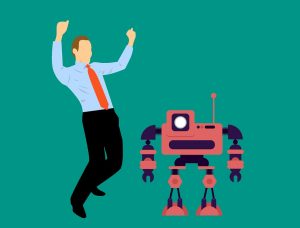
Automation of jobs is an unfolding phenomenon at the moment. As discussed in one of my previous blog posts, there is some sense of worry and anxiety concerning this. There are industry reports, statistical estimates and numerous media articles, which all suggest the possibility of robots replacing humans across many jobs, of robots ‘taking over’… For example, drivers might worry indeed, as according to one account there is an 89% risk of this job being automated in the foreseeable future.
Contrary to this general worrisome sentiment, Ken Goldberg, professor and department chair of industrial engineering and operations research at UC Berkeley, suggests another perspective, in which AI is seen rather as a complement, and not a threat for the workforce. To decrease the anxieties, professor Goldberg explains that we are quite far from the picture of robots ‘taking over’ and that we are still going to need human truck drivers for the foreseeable future, as driving on the street is full of complexities. Robots might be quite good at precise tasks that have a clear pattern, for example driving on a freeway, yet, tasks which require intuition, flexibility, innovation and a holistic approach will still be predominantly concentrated in the human domain. Indeed, as a general population we seem to have unrealistic expectations towards AI capabilities, whereas a robot’s grasping technique is still at the level of a three-year old, and AI keeps failing the Turing test. Professor Goldberg notes that the human frontier is still as hard to master forAI as it was a decade ago.
So, robots are still far from taking over tasks, which need human qualities, yet they are probably perfect for the dull and standardized jobs, which no one else wants to do. And here is where we can see complementarity between AI and humans. Professor Goldberg speaks about ‘multiplicity’ – ‘a hybrid view of how new technologies and people might work in partnership toward human goals’. In such a view, machines might add up to the diversity that people bring to work, which might further improve processes and outcomes. In essence, what managers should understand and inform their employees about is that machines will be there to help everyone to do their jobs better.
Such potential for using AI to amplify human competence is clearly seen in the field of global mobility. As discussed in my previous posts, although global mobility functions are expected to take on a more strategic role, they still largely face the burden of compliance obligations and administrative tasks. Automation gives a positive outlook though; a recent Deloitte report indicates that interest and activity in automation technologies is growing, which allows to speed up administrative/transactional processes, thus freeing up time for more value-adding activities.
In conclusion, we might rightfully feel that we’re on the verge of a transition and automation will change the world of work. Yet, it seems that instead of the gloomy perspective of ‘robotsreplacing humans’, we could rather focus on the opportunities and widening horizons stemming from this new human-AI partnership.

